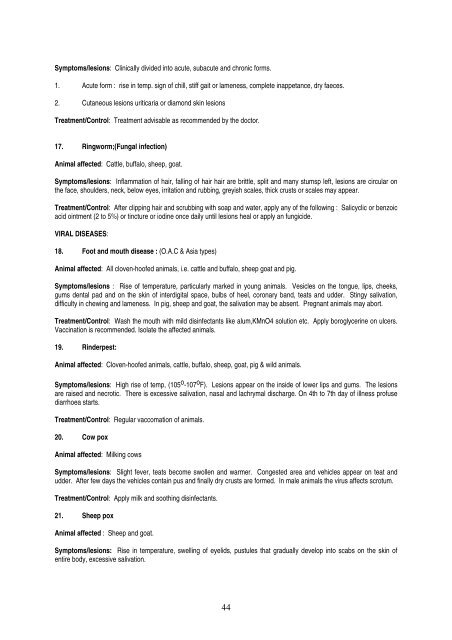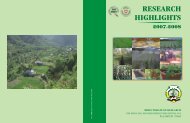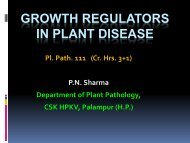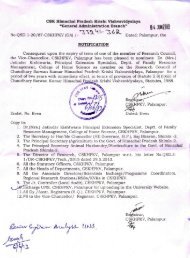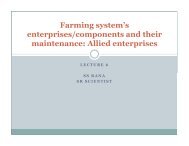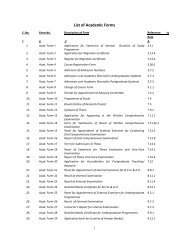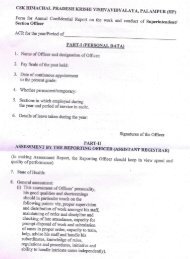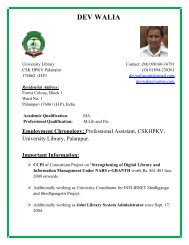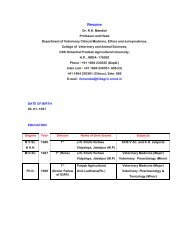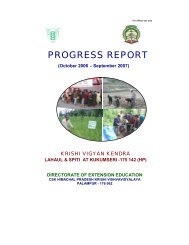animal production - CSK Himachal Pradesh Agricultural University ...
animal production - CSK Himachal Pradesh Agricultural University ...
animal production - CSK Himachal Pradesh Agricultural University ...
Create successful ePaper yourself
Turn your PDF publications into a flip-book with our unique Google optimized e-Paper software.
Symptoms/lesions: Clinically divided into acute, subacute and chronic forms.<br />
1. Acute form : rise in temp. sign of chill, stiff gait or lameness, complete inappetance, dry faeces.<br />
2. Cutaneous lesions uriticaria or diamond skin lesions<br />
Treatment/Control: Treatment advisable as recommended by the doctor.<br />
17. Ringworm;(Fungal infection)<br />
Animal affected: Cattle, buffalo, sheep, goat.<br />
Symptoms/lesions: Inflammation of hair, falling of hair hair are brittle, split and many stumsp left, lesions are circular on<br />
the face, shoulders, neck, below eyes, irritation and rubbing, greyish scales, thick crusts or scales may appear.<br />
Treatment/Control: After clipping hair and scrubbing with soap and water, apply any of the following : Salicyclic or benzoic<br />
acid ointment (2 to 5%) or tincture or iodine once daily until lesions heal or apply an fungicide.<br />
VIRAL DISEASES:<br />
18. Foot and mouth disease : (O.A.C & Asia types)<br />
Animal affected: All cloven-hoofed <strong>animal</strong>s, i.e. cattle and buffalo, sheep goat and pig.<br />
Symptoms/lesions : Rise of temperature, particularly marked in young <strong>animal</strong>s. Vesicles on the tongue, lips, cheeks,<br />
gums dental pad and on the skin of interdigital space, bulbs of heel, coronary band, teats and udder. Stingy salivation,<br />
difficulty in chewing and lameness. In pig, sheep and goat, the salivation may be absent. Pregnant <strong>animal</strong>s may abort.<br />
Treatment/Control: Wash the mouth with mild disinfectants like alum,KMnO4 solution etc. Apply boroglycerine on ulcers.<br />
Vaccination is recommended. Isolate the affected <strong>animal</strong>s.<br />
19. Rinderpest:<br />
Animal affected: Cloven-hoofed <strong>animal</strong>s, cattle, buffalo, sheep, goat, pig & wild <strong>animal</strong>s.<br />
Symptoms/lesions: High rise of temp, (105 o -107 o F). Lesions appear on the inside of lower lips and gums. The lesions<br />
are raised and necrotic. There is excessive salivation, nasal and lachrymal discharge. On 4th to 7th day of illness profuse<br />
diarrhoea starts.<br />
Treatment/Control: Regular vaccomation of <strong>animal</strong>s.<br />
20. Cow pox<br />
Animal affected: Milking cows<br />
Symptoms/lesions: Slight fever, teats become swollen and warmer. Congested area and vehicles appear on teat and<br />
udder. After few days the vehicles contain pus and finally dry crusts are formed. In male <strong>animal</strong>s the virus affects scrotum.<br />
Treatment/Control: Apply milk and soothing disinfectants.<br />
21. Sheep pox<br />
Animal affected : Sheep and goat.<br />
Symptoms/lesions: Rise in temperature, swelling of eyelids, pustules that gradually develop into scabs on the skin of<br />
entire body, excessive salivation.<br />
44


